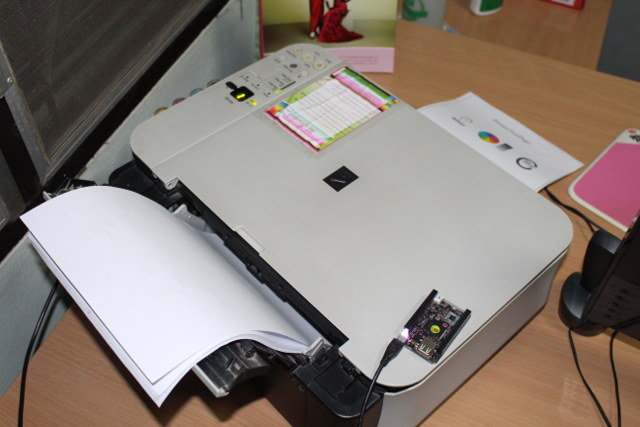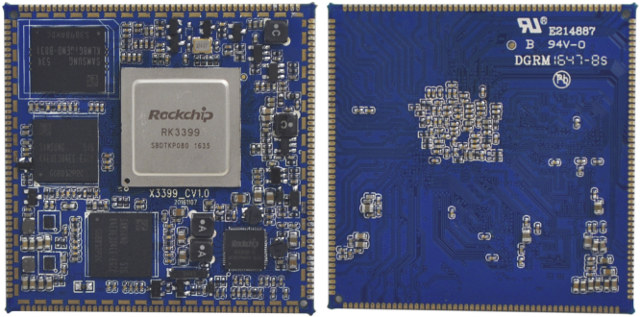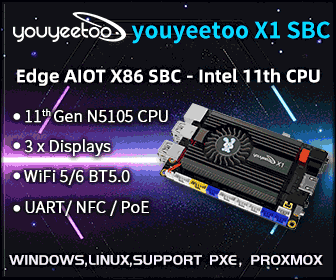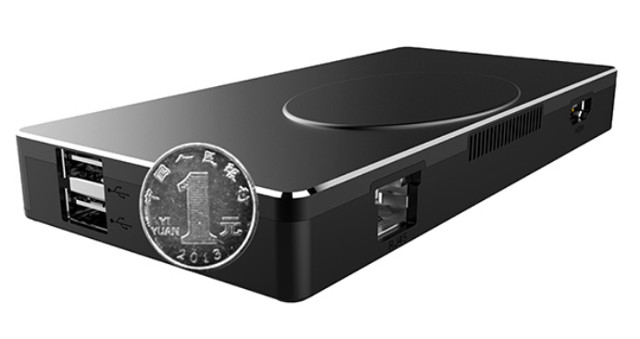We have a Canon Pixma MP250 series multi-function USB printer connected to a Windows 10 laptop at home, and for several years, I had no problems printing from my Ubuntu computer to that printer. However, this setup recently stopped to work, and whatever I would do, printing would never start from my Ubuntu PC, even though the file was (allegedly) successfully transfered to the Windows 10 laptop connected to the printer. So I decided to setup my own printer server, as well as a scanner server since it’s a multi-function printer, using one of the boards from my collection. As I opened my cabinet, I wondered whether I would use an Orange Pi board, Raspberry Pi board, or Nano Pi board, but I needed WiFi since there’s no Ethernet in the office where the printer is located, and I found that Next Thing CHIP board was the ideal candidate as […]
RJCLIP Repairs Ethernet RJ45 Clips in Seconds
Ethernet cables are normally made of RJ45 (8P8C) connectors that come with a clip that helps keeping the cables in place. However, over the years, I’ve broken a few of those, and the solution is normally to cut the cable, and replacing the broken RJ45 connector with a new one using a crimping tool and a cable tester (or multimeter). This does the job put normally takes a few minutes of your time, or more if you’ve messed up the connection the first time. I’ve just come accross an alternative solution with RJCLIP. It’s just a small plastic bit that simply fits on top of the broken RJ45 connector, and acts like if something ever happens. It just take a few seconds to put it on. Youtube user Vince tried it out, and it does seem to work pretty well, but also has some caveats with some type of connectors, […]
EU funded AXIOM Board is Powered by Xilinx Zynq UltraScale+ FPGA + ARM SoC
Back in 2015, Xilinx unveiled Zynq Ultrascale+ MPSoC combining ARM Cortex A53 & Cortex R5 cores, a Mali-400MP2 GPU, and UltraScale FPGA, and the company recently launched ZCU102 Evaluation Kit based on the SoC, which sells for just under $3,000. But if you are based in the European Union, you’ll be glad to learn about 4 millions Euros of your taxes have been spent to design a board based on the same MPSoC family as part of the AXIOM project, which was developed in collaboration with European universities and companies with the “aim of researching new software/hardware architectures for Cyber-Physical Systems (CPS) to meet the expectations” in terms of computational power, energy efficiency, scalability through modularity, easy programmability, and leverage of the best existing standards at minimal costs. AXIOM (Agile, eXtensible, fast I/O Module) board’s key specifications: SoC – Xilinx Zynq Ultrascale+ ZU9EG MPSoC with four ARM Cortex A53 cores […]
9Tripod X3399 SoM and Development Board are Powered by Rockchip RK3399 Hexa Core Processor
9Tripod (九鼎创展) has just launched X3399 system-on-module powered by Rockchip RK3399 hexa-core Cortex A72/A53 processor, and as well as a corresponding development board for people wanted to get started quickly before designing their own baseboard. X3399 core board preliminary specifications: SoC – Rockchip RK3399 hexa-core big.LITTLE processor with two ARM Cortex A72 cores up to 2.0 GHz, four Cortex A53 cores, and a ARM Mali-T860 MP4 GPU with OpenGL 1.1 to 3.1 support, OpenVG1.1, OpenCL and DX 11 support System Memory – 2GB LPDDR3 (2x Samsung K4E8E304EE-EGCF) Storage – 8GB eMMC 5.0 flash (Samsung KLM8G1GEND-B031) IOs – 204-pin to be soldered on baseboard PMIC – Rockchip RK808-D Dimensions – 55×55 mm 9Tripod does have a forum in English, but the company provides most of the information in Chinese. I could not find details about Linux or Android images and source code, except a few mentions of Linux Qt, Ubuntu, and […]
SigFox Launches Spot’it Low Cost GPS-Free IoT Geolocation Service
Asset tracking was traditionally done using a combination of cellular and GPS technology, and LPWAN standards like LoRa & Sigfox promised to lower the cost of communication and hardware while still relying on GPS technology, but Sigfox has just announced Spot’it geolocation service, which will get rid of GPS all together, and instead use radio signal strength analysis and deep learning techniques in order to provide location information both outdoors and indoors. Key benefits listed by the company include: Lowest-cost IoT location service – Spot’it does not require any additional hardware or software upgrades, and the device does not have to transmit more messages, meaning there is no impact on the solution operating cost for customers. Low energy – Spot’it does not rely on energy intensive GPS technology, nor require additional processing or any more energy than what Sigfox-enabled devices already consume. Enabled through a planetary network – Spot’it is embedded […]
$140 R-TV BOX K99 Android 6.0 mini PC Comes with Rockchip RK3399 SoC, 4GB RAM, 32GB Storage
We will the first hardware platforms shipping with a Rockchip RK3399 hexa-core processor later this month and in March, with Firefly-RK3399 development board, and various TV boxes / mini PCs such as Vorke Z3, Yundoo Y8, and Remix IO+. Another option is “R-TV BOX K99” with 4GB RAM, 32GB storage, Gigabit Ethernet, 802.1ac WiFi… that’s currently up for pre-order on GeekBuying for $139.99, and scheduled to ship in 3 days. R-TV BOX K99 specifications: SoC – Rockchip RK3399 hexa core processor with 2x ARM Cortex A72 cores @ up to 2.0 GHz, 4x ARM Cortex A53 cores, Mali-T860MP4 GPU @ 800 MHz with support for OpenGL ES1.1/2.0/3.0/3.1, OpenVG1.1, OpenCL, DX11, AFBC (frame buffer compression) System Memory – 4GB DDR3 Storage – 32 GB eMMC 5.1 flash + micro SD card slot Video Output – HDMI 2.0 up to 4K @ 60 Hz Video Codecs – 4K 10-bit H.265, H.264 & […]
$175 Bben MN17A Celeron N3450 Apollo Lake Mini PC Comes with an mSATA SSD Slot
The first Apollo Lake mini PC available from China was Voyo V1 VMac Mini with a Celeron N3450 or Pentium N4200 processor, but there’s now a new model with Bben MN17A with Celeron N3450, 4GB RAM, and 32GB eMMC flash, and the ability to add your own storage via an SSD bay. Bben MN17A mini PC specifications: SoC – Intel Celeron N3450 quad core processor @ 1.1 GHz / 2.2 GHz and 12 EU Intel HD graphics 500 @ 200 MHz / 700 MHz; 6W TDP System Memory – 4GB DDR3L (up to 8GB) Storage – 32GB eMMC flash (Options for 16, 64 or 128 GB) + mSATA SSD bay + micro SD slot up to 128 GB Video Output – HDMI 1.4b port up to 4K @ 30 Hz Audio – HDMI + 3.5mm audio jack Connectivity – Fast Ethernet, dual band 802.11 b/g/n/ac WiFi, and Bluetooth 4.2 (Intel […]
MYD-C437x-PRU Development Board Leverages TI Sitara AM437x Programmable Real-time Unit
MYIR Technologies launched MYC-C437x system-on-module based on TI Sitara AM437X processor, and the corresponding MYD-C437x development board at the end of 2015, but the latter did not make use of the processor’s PRU-ICSS (Programmable Real-Time Unit Subsystem and Industrial Communication SubSystem) block. The company has now released a new version of the baseboard called MYC-C437x-PRU which exposes I/Os pins to leverage the PRU-ICSS and enable implementation of protocols like EtherCAT and Profibus.MYD-C437x-PRU industrial development board specifications: System-on-Module – MYC-C437x module with SoC – Texas Instruments AM437x ARM Cortex A9 processor @ up to 1GHz with PowerVR SGX530 GPU (AM4378/AM4379 only) System Memory – 256 or 512MB (default) DDR3 SDRAM Storage – 4GB eMMC Flash (reserved 256/512MB Nand Flash design), 16MB QSPI Flash (unpopulated by default), 32KB EEPROM Connectivity – Gigabit Ethernet PHY Storage – 1x micro SD slot Serial ports – 1x 3-wire RS232 debug serial port, 2x 5-wire RS232 serial […]













